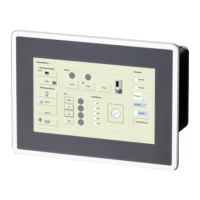6 Electrical installation
EMC-compliant wiring
6.2 EMC-compliant wiring
Notes on EMC-compliant wiring
General notes • The electromagnetic compatibility of the system depends on the type of installation
and care taken. Especially consider the following:
- Structure
- Shielding
- Earthing
• For installations differing from the one described, the evaluation of the conformity
with the EMC Directive requires a check of the system regarding the EMC limit
values. This for instance applies to:
- Use of unshielded cables
• The compliance with the EMC Directive is in the responsibility of the user.
- If you observe the following measures, you can assume that no EMC problems will
occur during operation and that compliance with the EMC Directive and the EMC
law is achieved.
- If devices which do not comply with the CE requirement concerning noise
immunity (EN 6100042) are operated close to the system, these devices may be
electromagnetically affected by the system.
Structure • Provide electrical contact between the device and the earthed mounting plate:
- Mounting plates with conductive surfaces (zinc-coated, stainless steel) allow
permanent contact.
- Painted plates are not suitable for an EMC-compliant installation.
• If you use several mounting plates:
- Connect as much surface of the mounting plates as possible (e.g. with copper
strips).
• When laying the cables, pay attention to the separation of signal cables and mains
cables.
• Lay the cables as close as possible to the reference potential. Freely suspended cables
act like aerials.
Shielding • Only use cables with braids if possible.
• The overlap rate of the shield should be higher than 80%.
• For data cables for serial connection, always use metal or metallised connectors.
Connect the shield of the data cable to the connector shell.
Earthing • Earth all metallically conductive components using suitable cables connected to a
central earthing point (PE bar).
• Maintain the minimum cross-sections prescribed in the safety regulations:
- For the EMC, not the cable cross-section is important, but the surface and the
contact with a cross-section as large as possible, i.e. large surface.
28
Lenze • BA_p300 • 2.0

